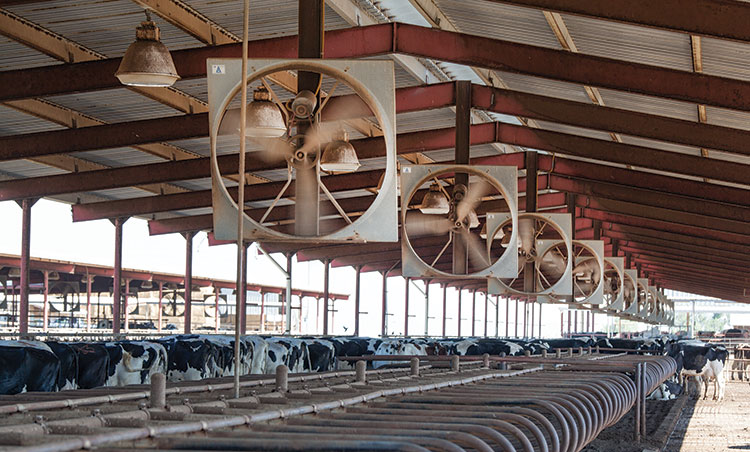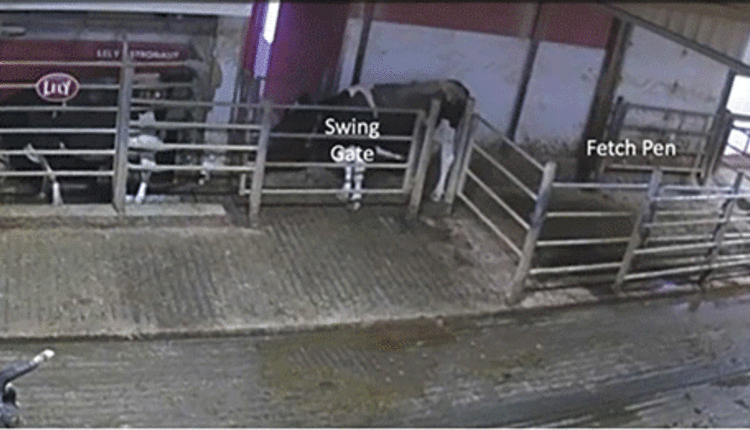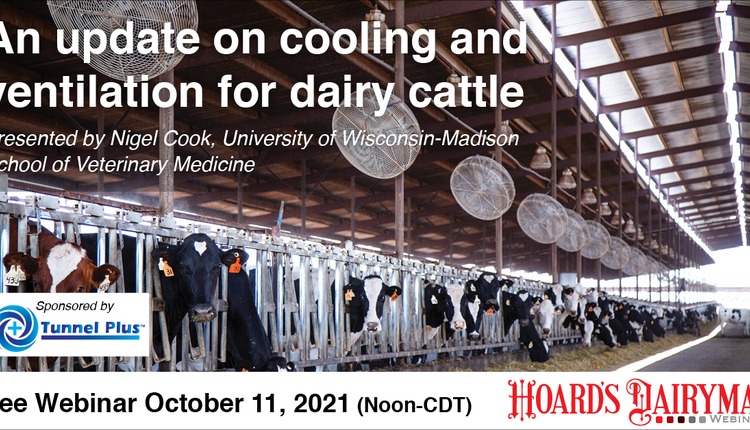 Three rules should guide ventilation design: fast-moving air in the resting space; effective exhaustion of heat and moisture; and the ability to transition between seasons.
Three rules should guide ventilation design: fast-moving air in the resting space; effective exhaustion of heat and moisture; and the ability to transition between seasons.Adult cows start experiencing heat stress at a THI (temperature humidity index) of 68 — typically around 65°F to 70°F in most climates, and high-producing cows generate a lot more heat than their lower producing predecessors. When housed in barns that may not be oriented optimally to capture prevailing winds, or in locations where multiple barns create wind shadows to adjacent buildings downwind, we observe heat-stressed animals with losses in milk production and fertility, lameness, mastitis, and poor fresh cow health.
In order to assist with cooling, we have used water to mist the air or soak the cows and fans to create localized fast-moving air in the pens and holding area. Recent research studies have made us more aware that cows accumulate heat when they lie down. During a lying bout, body temperature may rise by approximately 1°F per hour, emphasizing the importance of airflow in the microenvironment of the stall. Target air speeds of approximately 400 feet per minute are suggested to keep cows resting in freestalls, so each row of stalls should be supplied with fans.
Traditional recommendations for spacing panel fans at 10 times the fan diameter do not appear to be sufficient for most 48- to 52-inch diameter fans. Instead, we recommend to space fans on roof supports every 20 to 24 feet at a height of 8 to 9 feet angled downward to maximize the distribution of air.
Of note when choosing any fan is the twofold variation in ventilation efficiency ratio (CFM or cubic feet per minute per watt) observed between tested fans with CFM output and wattage ratings. We emphasize shopping around for the best fan for the purpose. Some fans can distribute fast-moving air further and be spaced at intervals up to 60 feet apart.
Keep the air moving
Fast-moving air in the resting space only gets us part of the way toward cool, happy cows, though. If we do not find a way to expel the heat and moisture from the barn, the system will still fail. That is why we have seen mechanical systems created to circumvent the reliance on weather.
Tunnel barns move air along the length of the barn from one end to the other, while cross ventilation barns move the air perpendicular to the feed lanes. Each system may be described by using air speed through the cross-sectional area of the barn (for example, 5 miles per hour), using body mass/heat transfer (for example, minimum 1,000 CFM per adult cow), or using air changes per hour (ACH) (for example, 4 ACH for the winter and 40 to 60 ACH for the summer).
Current building standards allow for a wide range of interpretation, and it is not uncommon to find barns specified at much higher air speeds — up to 9 mph, and air changes per hour may exceed 80 or 90! This variability underscores some of the frustrations with these systems that promise so much.
In tunnel barns, the air will tend to move down the feed lanes and alleys and avoid the cow occupied zones of the freestalls. Baffles do little to alter this effect, and false ceilings or lower roof pitches help reduce the volume of the barn but still create dead zones. Elevating the cross-sectional air speed will likely only pull more air into the feed lane from the pens, so the solution has been to return to putting fans back over the stalls.
With fast-moving air in the resting space, we can return to more reasonable air changes per hour of 40 to 60 for summer ventilation rates. Air quality issues start to come into play at approximately 500 feet in barn length, which impacts the size and layout of the pens we can use within this system.
Cross-vent barns have been popular in the industry but also face some challenges. Some barns are specified based solely on air speed under the baffles, which typically redirect fast-moving air over the stalls in the pens. In these cases, air changes per hour can be very low, leading to problems exhausting heat and moisture from the barn.
This problem is coupled with the tendency for air to get trapped between the baffles, increasing the time it takes to move across the barn toward the exhaust fans. While the air travels perpendicular to the feed lanes in these barns, there are still large cross alleys where we see airflow focused, pulling air from the ends of the pens.
There is also a tendency to keep adding rows of stalls to these facilities. This can look very attractive from a cost perspective as we go from 8 to 16 or 20 rows of stalls with no additional fans added to the system, but this does little to improve air quality in these barns, especially during the winter where slow-moving air gets trapped within the barn.
Solutions to these issues are a work in progress and include raising baffle heights, installing retractable baffles or even removing the baffles, and returning yet again to fans over the stalls. Some facilities also use secondary air inlets at the ridge to freshen the air as it moves through the barn. Practically, we may need to limit the number of stall rows to 10 or so before we run into air quality issues.
The best combination
Some producers have looked at these different systems and decided that they want more options. Hybrid barns are mechanically ventilated facilities that retain a natural ventilation option in the winter. These barns are usually designed like tunnel ventilation systems, but they have a ridge that can be managed either with a curtain or a series of cupolas each fitted with an exhaust fan, and they have curtain side walls to control inlet sizing.
In the summer, they ventilate as a tunnel, with the addition of fans over the stalls. In the transitional periods and over winter, they can be switched to natural ventilation by opening the eaves and venting through the ridge. With a cupola system, eight-row barns with two feed lanes can be designed this way, and while these barns are the most expensive to build, they also offer the most flexibility in terms of their operation.
Finally, with all these systems, thought has to be given to the ramping functions used —how does the system transition from summer to winter and winter to summer? The barn should ventilate just as well across all seasons. Our current perspective is that the cost of heat stress and disease far outweighs the cost of overventilation.
In the future, we look to biofeedback systems where cow sensors would drive the ventilation system. We know this is important as cows continue to be heat stressed well into the night in many situations, where the ventilation and cooling have already been turned down or off.
The optimal ventilation system will provide fast-moving air in the cows’ resting space, exhaust the heat and moisture from the barn in the summer, and transition effectively between seasons. Each system has its strengths and weaknesses, but following these three simple rules will ensure that the cow environment will be optimized in each system.










